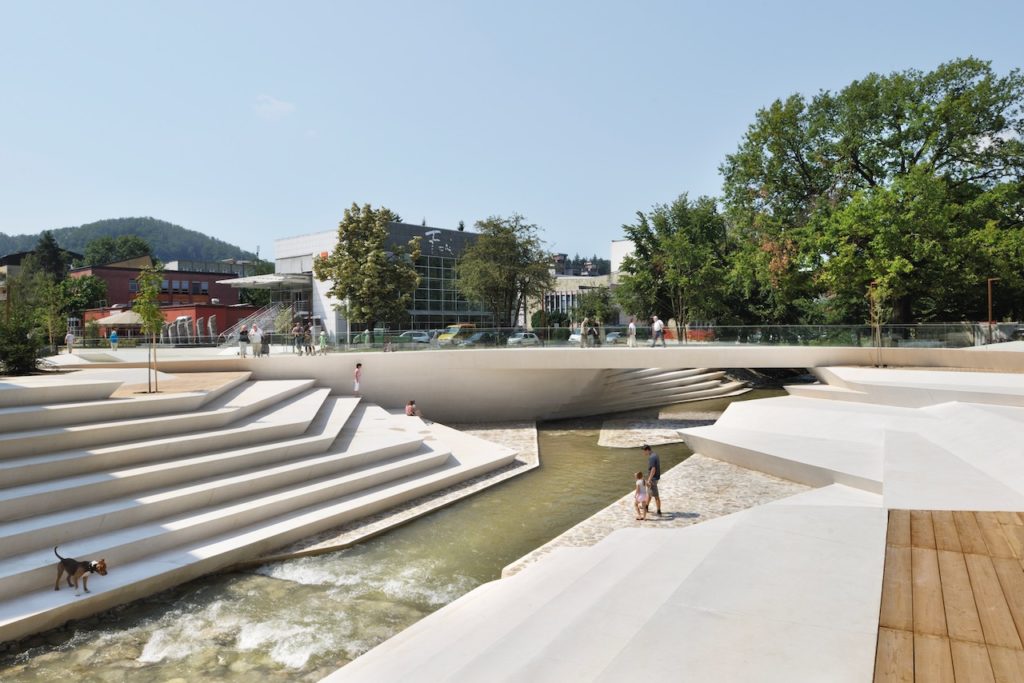
Architect
ENOTA
Type of Area
Stream with artificial banks
Land/water interaction
Bridges
Terrace/steps
Decking
Built Environment Types
Moderately built
Moderate green
Scale of Impact
City
Intervention Scale (Spatial)
Moderate site
Project Types
Public space regeneration
Urban design
Urban waterfront restoration
Urban/ Rural
Urban core
Visibility and Openness
Fully enclosed
Fully contained
City centre revitalisation
The Velenje “Promenada” is both a public space and a pedestrian connection to the city centre of Velenje, Slovenia, that bridges the river Paka. It was planned and constructed in stages by ENOTA ARCHITECTS starting in 2014 as part of the ongoing revitalisation of the entire city centre. Velenje is an industrial post-war town, laid out on modernistic principles and its special character and identity needed to be respected while meeting contemporary requests for bringing more life into the city. As a consequence, all foreseen activities needed to be concentrated in the centre to ensure a critical mass and a continuity of activities.
The modernistic urban lay-out offered sufficient area to accommodate additional programmed activities. These unoccupied grounds, however, had become car parks, despite being labelled as a pedestrian zone and this affected the quality of open space uses. This was a problem which increased with more visitors. A pre-condition for the project was therefore to increase the amount of parking to free up space by adding multi-level parking facilities.
Three main linear spaces for pedestrians cross the city centre and visually tie it together: a park, a street and the promenade. While each offers different uses of the space, they needed a distinct visual character. All of the content of the available and foreseen activities was to be concentrated into these linear spaces to prevent the creation of urban voids and to channel people’s movement during events.
In the first phase the public spaces were provided with simple surfaces for a range of activities, which only required modest investment. This allowed for future expansion and additional content as required. The water-level of the river increases a few times a year, but remains low at all other times, generally being invisible. The park was extended across both banks of the river and footbridges link into the network of paths situated on either bank, giving access to the formerly overgrown river. The street is enhanced by additional cultural and commercial programmes, such as open-air market events and features concrete elements to frame the space for additional activities.
The first lay-out of the promenade was created by closing it to the traffic, but it retained the character of a road and did not contribute to active public life. Thus, the initial straight connection was transformed into a sequence of widened surfaces, connected by a twisting narrower path leading towards a new amphitheatre along the river. Space for the construction of this amphitheatre was gained by narrowing the old road bridge, then terraced surfaces gradually fall towards the river. The riverbed divided the area in half but by modifying the riverfront and creating terraces towards the water level, it focuses different activities and connects them into a unified whole.
Perception and Meaning
Accessibility
Place identity
Imageability
Health and Wellbeing
Place affordance
Increased physical activities
Increases socialisation
Interaction with Water
Visual
Tactile – touching

This project performs well for accessibility. This is a project in a modernist context, so the absence of references to the cultural heritage are different and there are also almost no landmarks.
It is considered to be modest in terms of maintenance requirements. It is generally well provided with facilities, but the range as well as lack of shade and especially shelter are weaker due to the bridge-like concept and location. The health and well-being aspect lacks potential, except for expressing the genius loci and safety aspects.
It provides good connection to water but lacks safety equipment and immediate access from the water. This project performs poorly in most activity categories, owing to its location and design, although there are children’s play activities available. The project is excellent at achieving formal quality given the location and spatial limitations.
